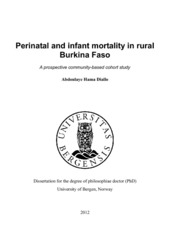| dc.contributor.author | Diallo, Abdoulaye Hama | en_US |
| dc.date.accessioned | 2013-01-21T09:28:52Z | |
| dc.date.available | 2013-01-21T09:28:52Z | |
| dc.date.issued | 2012-12-07 | eng |
| dc.identifier.isbn | 978-82-308-2172-5 | en_US |
| dc.identifier.uri | https://hdl.handle.net/1956/6281 | |
| dc.description.abstract | Background: Recent reports estimated the annual number of stillbirths and under-five year child deaths occurring in the world to 3.2 million and 7.7 million, respectively. Over 95% of these deaths only occur in low-income countries, mainly in sub-Saharan Africa. Burkina Faso in West Africa is one of the poorest countries in the world with reported very high perinatal mortality rate (PNMR), neonatal mortality rate (NMR), infant mortality rate (IMR) and under-5 mortality rate (U5MR), but the routine statistics are of poor quality and there are few prospective cohort data. We took opportunity of the PROMISE-EBF trial that promoted exclusive breastfeeding by peer-supporters in four African countries including Burkina Faso, to conduct a study on the epidemiology of perinatal and infant mortality in a rural area in Southern Burkina Faso. Methods: We conducted a prospective, community-based cohort study in 24 villages of Banfora Health District. During one year (2006-2007), all pregnant women were identified by communityinformants. Trained data collectors contacted the women to obtain informed consent, to perform the recruitment interview and later to conduct postpartum follow-up home visits at week 1, 3, 6, 12, 24 and at 12 months. Data collection at recruitment included maternal socio-demographic baseline, medical history and antenatal use of health services. Data collection during follow-up included the pregnancy outcomes, the circumstances of delivery, and the child feeding patterns, illness episodes, and anthropometry. Verbal autopsies were conducted in case of perinatal or infant death. Data were collected using electronic questionnaires on an early version of openXdata software, cleaned and analysed on Stata/SE 11.0. PNMR, NMR and IMR were calculated as proportions of perinatal, neonatal and infant deaths, respectively, and the 95% CIs of each outcome were calculated accounting for the cluster-design of the main EBF-study. Binomial regression was used to screen and identify risk factors for perinatal death, with a generalized-estimating equations (GEE) model to account for the cluster-design of the study. Logistic regression was used to identify predictors of neonatal death with a random-effects model to account for the cluster-design of the EBF-study. Cox regression was used to identify risk factors for infant death with a gamma-frailty model to account for the clusterdesign of the main study. Results: A total of 895 women were enrolled. The mean age was 26 (±6) years and only 17% of women were nulliparous at enrolment, and the median parity was of 3 for multiparae. Over 80% of participants had no formal education, about 95% were married and 48% lived in polygynous households. Overall, 54% of women delivered at home and 36% in a health facility. The pregnancies resulted in 915 births (of which 20 pairs of twins), 49 stillbirths, 866 live births, 40 neonatal deaths and 98 infant deaths. The stillbirth rate (SBR) and the PNMR were, 54 (95% CI 38-69), 79 (95% CI 59-99) per 1000 births, respectively. The proportion of perinatal deaths did not differ between home deliveries (8%) and facility births (7.6%, p=0.81). The NMR and the IMR were 46 (95% CI 22-70) and 113 (95% CI 89-143) per 1000 live births, respectively. We found that 57% of neonatal deaths occurred just during the first week of life and neonatal deaths represented 41% of all infant deaths. The proportions of neonatal deaths were higher in home deliveries (5.4%) as compared to facility births (3.2%, p=0.06). Most of infant deaths (90%) took place at home. Multivariable analyses of the factors associated with perinatal death risk showed that foetuses from nulliparous and primiparae had 3 (RR=2.9, 95% CI 1.6-5.0) and 2 (RR=2.2, 95% CI 1.2-3.9) times, respectively, higher perinatal death risk compared to that from multiparous with 2-4 previous births. Babies born during the dry season had a doubling (RR=2.1, 95% CI 1.3-3.3) of the risk of perinatal death in comparison to their peers born during the rainy season and twins carried a 4-fold (RR=4.0, 95% CI 2.3-6.9) higher risk of perinatal death as compared to singletons. Adjusted analyses on the predictors of neonatal death risk showed that children born in polygynous households had a doubling (OR=2.1, 95% CI 1.0-4.7) of the odds of neonatal death compared to their peers from monogamous households. Newborns from nulliparous mothers had 4 times (OR=4.3, 95% CI 1.5-12.1) increased odds of neonatal death in comparison to those of mothers with 2-4 previous births and twins were found to have over 11-fold (OR=11.5, 95% CI 4.5-29.8) higher odds of neonatal death. Adjusted analyses on the risk factors for infant death found that infants from polygynous households carried over 2 times (HR=2.4, 95% CI 1.4-4.0) higher rate of death than their peers from monogamous households and children born to mothers with a previous child death were found to have 60% (HR=1.6, 95% CI 1.0-2.6) increased rate of infant death. Twins had 8-fold (HR=8.4, 95% CI 4.6-15.3) higher rate of infant death compared to singletons. Conclusion: The burden of perinatal and infant mortality was found to be unacceptably high in Banfora Health District and this is likely the case in other rural areas of Burkina Faso. Nulliparous and primiparae, women living in polygynous households, mothers with a history of child death, a birth during the dry season and twin births were factors associated with increased risk of fetal loss, neonatal or infant death. Our findings call for urgent actions from the national health authorities in Burkina Faso as well as from local communities in rural settings. | en_US |
| dc.language.iso | eng | eng |
| dc.publisher | The University of Bergen | eng |
| dc.relation.haspart | Paper I: Diallo, A. H., Meda, N., Zabsonré, E., Sommerfelt, H., Cousens, S., Tylleskär, T. and The PROMISE-EBF study group. (2010) Perinatal mortality in rural Burkina Faso: a prospective community-based cohort study. BMC Pregnancy and Childbirth 2010, 10:45, August 2010. The article is available at: <a href="http://hdl.handle.net/1956/6279" target="blank">http://hdl.handle.net/1956/6279</a> | en_US |
| dc.relation.haspart | Paper II: Diallo, A. H., Meda, N., Ouédraogo, W. T., Cousens, S. and Tylleskär, T. for the PROMISEEBF study group. A prospective study on neonatal mortality and its predictors in a rural area of Burkina Faso: Can MDG-4 be met by 2015? Journal of perinatology 31(10): 656–663, October, 2011. Full text not available in BORA due to publisher restrictions. The article is available at: <a href="http://dx.doi.org/10.1038/jp.2011.6" target="blank"> http://dx.doi.org/10.1038/jp.2011.6</a> | en_US |
| dc.relation.haspart | Paper III: Diallo AH, Meda N, Sommerfelt H, Traoré SG, Cousens S and Tylleskar T for the PROMISE-EBF study group. (2012) The high burden of infant deaths in rural Burkina Faso: a prospective community-based cohort study. BMC Public Health 2012, 12:739, September 2012. The article is available at: <a href="http://hdl.handle.net/1956/6280" target="blank">http://hdl.handle.net/1956/6280</a> | en_US |
| dc.relation.haspart | Paper IV: Diallo, A. H. and Meda, N. (2010) Estimates of mortality in children younger than 5 years for Burkina Faso. Lancet 376(9748): 1223-1224, October 2010. Full text not available in BORA due to publisher restrictions. The article is available at: <a href="http://www.sciencedirect.com/science/article/pii/S0140673610618806" target="blank"> http://www.sciencedirect.com/science/article/pii/S0140673610618806</a> | en_US |
| dc.title | Perinatal and infant mortality in rural Burkina Faso. A prospective community-based cohort study | en_US |
| dc.type | Doctoral thesis | |
| dc.rights.holder | Copyright the author. All rights reserved | |

